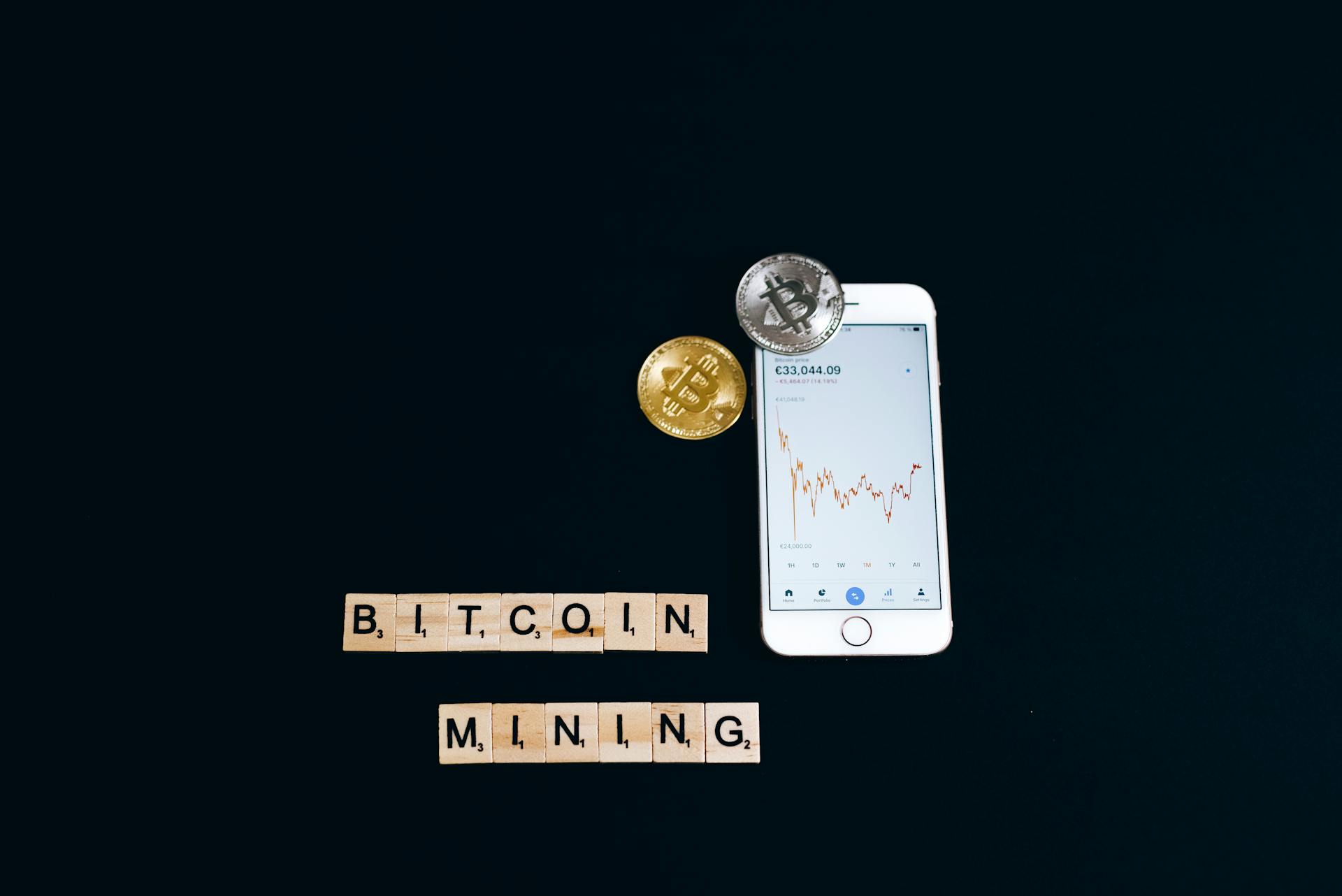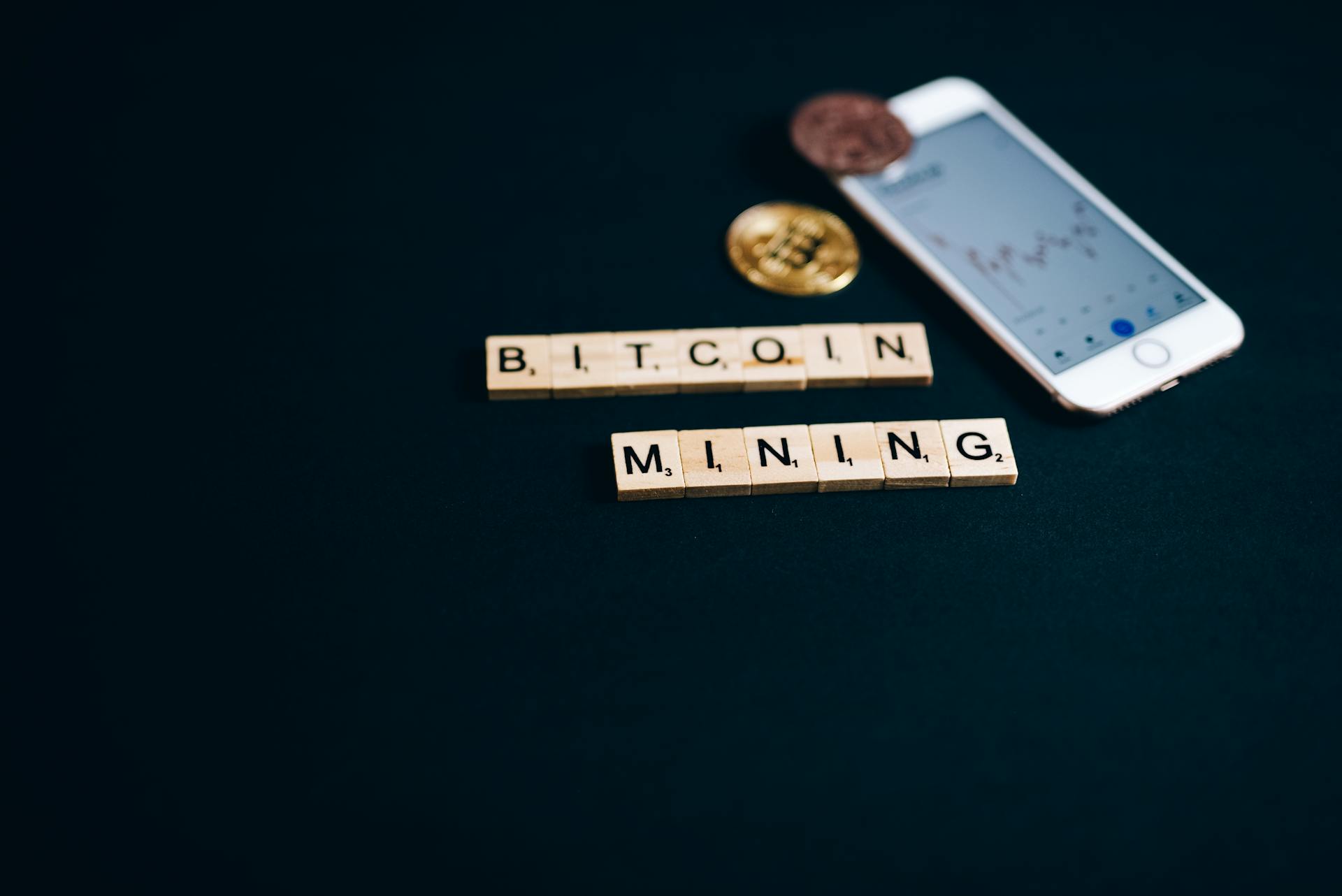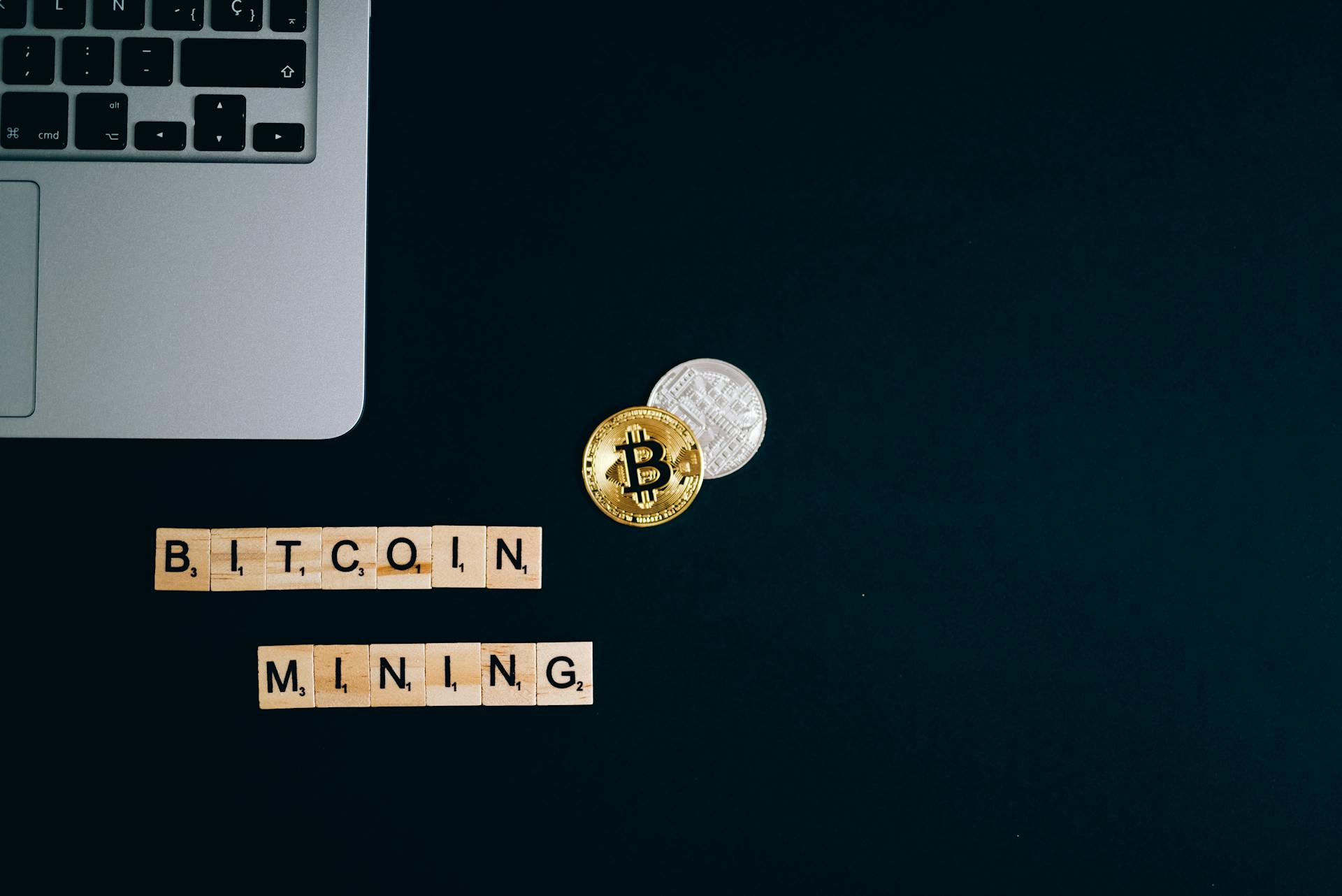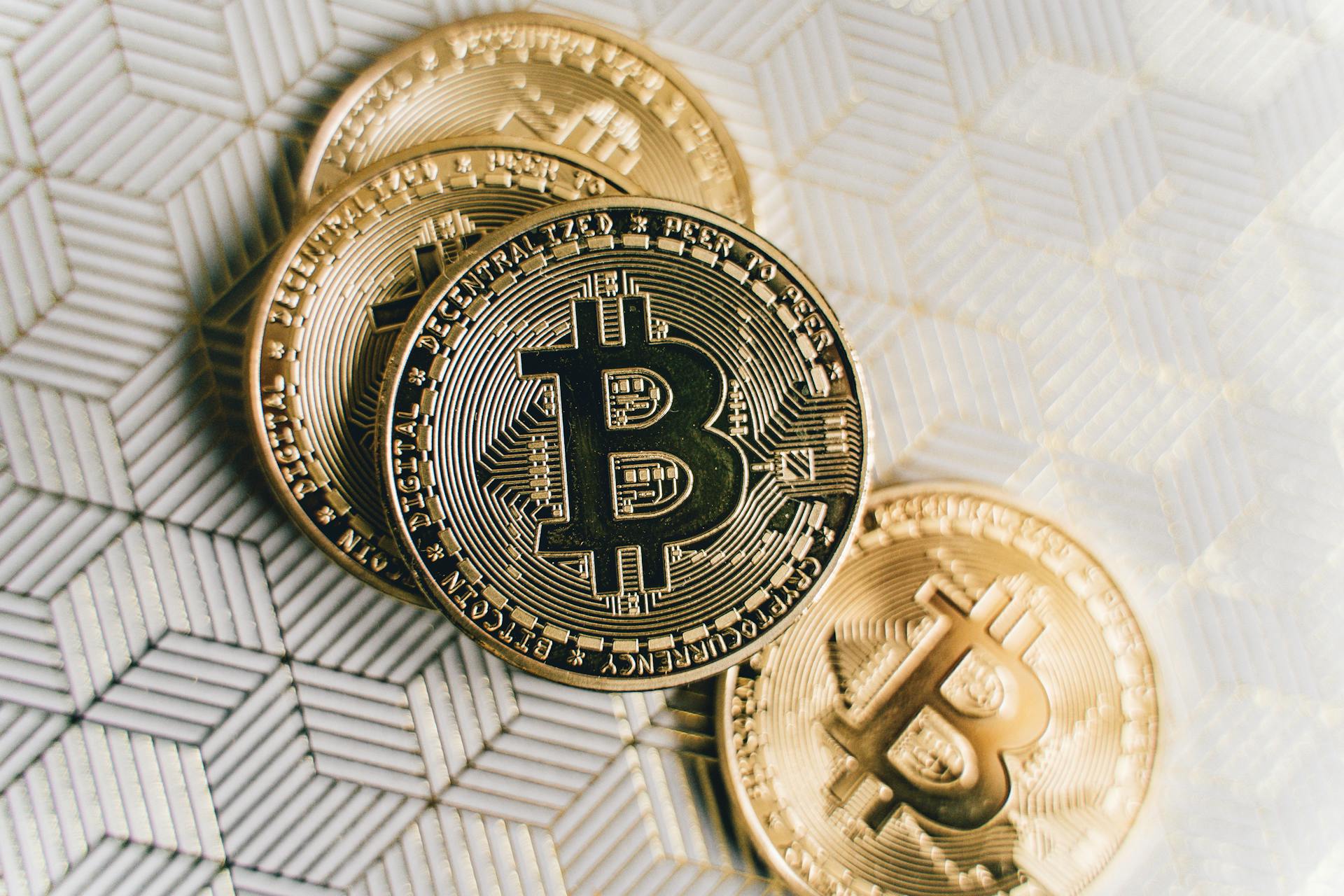
Bitcoin mining is a complex process, but at its core, it's a way to secure the Bitcoin network and verify transactions.
The mining process involves solving complex mathematical equations, which requires powerful computers and a lot of energy.
The reward for solving these equations is a certain number of newly minted Bitcoins, currently set at 6.25 BTC.
However, the real question is whether Bitcoin mining is worth the investment.
What is Bitcoin Mining?
Bitcoin mining is the process of verifying transactions on the Bitcoin network and adding them to the public ledger called the blockchain. This is done by powerful computers solving complex mathematical equations, known as hashes.
These computers, called mining rigs, are typically housed in large warehouses or data centers and are maintained by professional mining operations. They can consume massive amounts of energy, often rivaling the power consumption of small towns.
The purpose of mining is to secure the Bitcoin network and verify the integrity of transactions, ensuring that all transactions are valid and that no one is attempting to cheat the system. Mining also helps to prevent double-spending, where a user tries to spend the same Bitcoin multiple times.
As a result, miners are rewarded with newly minted Bitcoins, which are added to the supply of Bitcoin in circulation. This reward incentivizes miners to continue validating transactions and securing the network.
You might like: Bitcoins Transactions per Second
Is Bitcoin Mining Legit?
Bitcoin mining is a legitimate process, but there are some misconceptions that need to be addressed. In most countries, Bitcoin mining is legal, but some countries have banned it due to concerns over energy consumption and financial stability.
It's essential to check local regulations before starting any mining operations. This is because some countries have specific laws and regulations surrounding Bitcoin mining.
Here are some common myths about Bitcoin mining:
- Myth: Bitcoin mining is illegal.
- Myth: Bitcoin mining is a scam.
- Myth: Bitcoin mining is easy money.
These myths are not entirely true. While there are scams related to mining, the process itself is legitimate. Bitcoin mining involves solving complex mathematical problems to validate transactions on the blockchain.
Understanding
Bitcoin mining is the process of validating and adding new transactions to the Bitcoin blockchain. Miners use powerful hardware to solve complex mathematical problems, known as hashes, which require significant computational power.
The first miner to solve the problem is rewarded with newly minted Bitcoins. This process is essential for maintaining the security and integrity of the Bitcoin network, ensuring that transactions are valid and preventing double-spending.
Bitcoin mining is different from trading, where you buy and sell cryptocurrencies on various platforms. Both mining and trading can be profitable, but they require different strategies and approaches.
Here are some key facts about Bitcoin mining:
In summary, Bitcoin mining is a complex and resource-intensive process that requires careful planning and consideration. It's essential to understand the costs and risks involved before diving in.
Protecting Your Information
Protecting your personal information while mining Bitcoin is crucial. You need to be vigilant and cautious of suspicious emails, websites, or applications related to Bitcoin mining.
Hackers often use phishing techniques to trick users into revealing their personal information. Phishing attempts can be detected and blocked with reliable security software.
Create strong and unique passwords for your mining accounts, and never share them with anyone. Consider using a password manager to securely store your passwords.
A secure home network is essential for protecting your mining activities and personal information. Use strong encryption, such as WPA2, and regularly update your Wi-Fi router's firmware.
Regularly updating your mining software and operating system is vital to protect against known vulnerabilities. This will help prevent unauthorized access to your mining activities and personal information.
Consider encrypting your mining data and personal files using encryption software. Encryption adds an extra layer of protection, making it more challenging for hackers to access your sensitive information.
Enable two-factor authentication (2FA) whenever possible. This adds an extra layer of security by requiring a second form of verification, such as a unique code sent to your mobile device, in addition to your password.
Here are the essential steps to protect your personal information while mining Bitcoin:
- Stay vigilant and cautious of suspicious emails, websites, or applications.
- Use reliable security software to detect and block potential threats.
- Create strong and unique passwords for your mining accounts.
- Secure your home network using strong encryption and regular firmware updates.
- Regularly update your mining software and operating system.
- Consider encrypting your mining data and personal files.
- Enable two-factor authentication whenever possible.
The Risks of Bitcoin Mining
Protecting personal information is a significant risk in bitcoin mining, as hackers and scammers often target miners and enthusiasts to gain access to their personal data.
Hackers use malware to gain unauthorized access to computers, steal sensitive information, and even install Bitcoin mining malware on unsuspecting users' computers.
One common method used by hackers is the distribution of malware, which is malicious software designed to gain unauthorized access to computers and steal sensitive information.
On a similar theme: Can Someone Steal My Crypto with My Wallet Address
Threat of Malware
Malware is a significant threat to Bitcoin miners, used by hackers to gain unauthorized access to computers and steal sensitive information.
One common method used by hackers is the distribution of malware, specifically designed to target Bitcoin miners and mining enthusiasts.
Hackers can install Bitcoin mining malware on unsuspecting users' computers, allowing them to use the resources of those computers for their mining operations.
This type of malware can be extremely difficult to detect, and once installed, it can cause significant damage to your computer and compromise your personal data.
Bitcoin mining malware can also be used to steal your personal information, putting you at risk of identity theft and other cybercrimes.
Protecting yourself from malware is crucial in the world of Bitcoin mining, so be sure to take necessary precautions to safeguard your computer and personal data.
Additional reading: Bitcoin Mining Quantum Computer
From GPUs to ASICs: The Shift
The shift from GPUs to ASICs marked a significant turning point in Bitcoin mining.
The use of regular home computers with CPUs was initially sufficient, but as the difficulty of mining increased, this method became inefficient.
GPUs were more powerful and could handle complex tasks better, making them a popular choice among miners.
However, GPUs are more expensive than CPUs and can only mine a limited number of cryptocurrencies.
ASICs, on the other hand, are custom-built for mining Bitcoin and offer far superior efficiency and computing power compared to GPUs and CPUs.
ASIC miners are the most powerful and efficient miners in the market, but they are also expensive and can only be used for mining Bitcoin and a few other cryptocurrencies.
Despite their high cost, ASIC miners are a popular choice among serious miners due to their high hash rates and energy efficiency.
Suggestion: Most Expensive Crypto Coin
Economic and Environmental Impact
Bitcoin mining can be a viable investment, but its economic risks and rewards are constantly shifting due to market fluctuations.
The cryptocurrency market's constant changes make it challenging to determine whether bitcoin mining is still a worthwhile investment.
On a similar theme: Bitcoin Mining Investment
Some miners are turning to sustainable practices, using clean energy sources like wind and solar power to reduce carbon pollution from mining.
This shift towards sustainability can be a cost-effective option for miners, as renewable energy can be cheaper than traditional energy sources.
Miners face significant regulatory challenges, including environmental regulations and financial compliance, which can impact their operations.
Stricter compliance standards are being enforced, particularly concerning environmental impacts, which is driving the adoption of renewable energy sources in mining operations.
Miners must adapt to these changes to continue operating legally and sustainably, which can be a significant challenge for those who are not prepared.
A different take: Environmental Impact of Bitcoin
Regulatory and Technological Landscape
Governments are starting to make rules about how Bitcoin mining can be done, aiming to make it more sustainable. Regulatory policies are crucial for reducing the environmental footprint of Bitcoin mining.
The environmental footprint of Bitcoin mining is a complex issue, but clean energy and smart regulations can help make it better for the planet. Stricter compliance standards are being enforced, particularly concerning environmental impacts.
Innovations in Bitcoin mining technology are expected to focus on making mining more sustainable and less energy-intensive. This includes exploring alternative mining models that could address Bitcoin's supply and sustainability challenges.
Curious to learn more? Check out: Bitcoin Mining Power Consumption
Technological Advances
The mining industry is constantly looking for better ways to mine Bitcoin, driving innovations in mining hardware.
New hardware is being developed to make mining more efficient, with some companies exploring renewable energy sources to power their operations, reducing costs and addressing environmental concerns.
The focus is on creating hardware that is both powerful and energy-efficient.
As technology advances, we can expect to see even more efficient and powerful mining solutions.
The evolution of Bitcoin mining technology reflects the ongoing quest for more efficient and powerful solutions, from CPUs to GPUs and now ASICs, highlighting the rapid advancements in the field.
Innovations are expected to focus on making mining more sustainable and less energy-intensive, addressing Bitcoin's supply and sustainability challenges.
Curious to learn more? Check out: Bitcoin Atm Tampa - Coinhub
Future Legal Trends
The regulatory landscape of Bitcoin mining is constantly evolving, with governments around the world creating new rules to manage this growing industry. Regulatory challenges and compliance are top of mind for miners, who must adapt to stricter standards, particularly concerning environmental impacts.
Miners face numerous regulatory challenges, including environmental regulations and financial compliance. Stricter compliance standards are being enforced, particularly concerning environmental impacts. This regulatory shift is expected to accelerate the integration of renewable energy sources in mining operations.
Governments are expected to focus on the environmental footprint of mining activities and the necessity of clean energy mining. Increased scrutiny and more stringent operational standards are likely to be implemented in the future. The future of Bitcoin mining regulations is likely to involve more stringent operational standards.
Bitcoin mining's legal status varies widely across the globe, with some countries embracing it and others imposing strict bans. For instance, China has cracked down on mining activities, whereas countries like the United States have more lenient regulations. Governments around the world are building out new regulations for cryptocurrencies.
You might like: Ripple Cryptocurrency Future
Choosing and Using a Miner
Choosing a miner can be a daunting task, but it's essential to consider your budget and the potential return on investment before making a purchase. ASIC miners are the most expensive, followed by GPU miners and CPU miners.
To determine the best miner for you, you should also consider the hash rate and mining power. A higher hash rate results in faster mining and higher chances of earning rewards. The hash rate of MinerX-2000, for example, is 2000 TH/s.
Energy efficiency is another crucial factor to consider, as mining requires a significant amount of electricity. Look for miners with high energy efficiency to minimize operating costs and environmental impact. MinerX-2000 claims to be one of the most efficient miners in the market.
Before purchasing a miner, ensure that it is compatible with the mining software you plan to use. Some miners may require specific software or configurations. It's also essential to research the reputation of the miner manufacturer and read customer reviews to gauge the reliability and performance of the miner.
Here are some key factors to consider when choosing a miner:
Cost of the minerli>Hash rate and mining powerEnergy efficiencyCompatibility with mining softwareReputation and customer reviews
Recommended read: Bitcoin Miner Game Legit
Choosing a Miner

The type of miner you choose will depend on your budget, mining goals, and energy efficiency requirements. There are three primary types of Bitcoin miners: ASIC miners, GPU miners, and CPU miners.
ASIC miners are the most powerful and efficient miners in the market, but they are also the most expensive. They are specifically designed to mine Bitcoins and offer the highest hash rates.
GPU miners use graphics cards to mine cryptocurrencies and are more versatile than ASICs. They are also more affordable than ASICs, making them a popular choice among miners.
CPU miners use the computer's CPU to mine cryptocurrencies and are the most accessible option, but they are the least powerful and not as profitable as GPU or ASIC mining.
When choosing a miner, consider factors such as cost, hash rate, energy efficiency, compatibility with mining software, and reputation. Each miner has its own specifications and features, and it's crucial to select one that aligns with your mining goals and budget.
Discover more: Gpu Mining vs Cpu Mining

Here are the key factors to consider when choosing a miner:
- Cost of the miner: ASIC miners are the most expensive, followed by GPU miners and CPU miners.
- Hash rate and mining power: The hash rate determines how quickly a miner can solve mathematical problems.
- Energy efficiency: Mining requires a significant amount of electricity, so look for miners with high energy efficiency.
- Compatibility with mining software: Ensure that the miner is compatible with the mining software you plan to use.
- Reputation and customer reviews: Research the reputation of the miner manufacturer and read customer reviews to gauge the reliability and performance of the miner.
Combining and Trading
Combining mining and trading can be a great way to maximize profits. Miners can use their mining rewards to invest in cryptocurrencies and take advantage of price movements.
Market volatility can impact the value of both mined and traded cryptocurrencies, so it's essential to be aware of the risks. Trading requires time and effort for market analysis and decision-making.
Careful planning and risk management are crucial for successful mining and trading operations. It's recommended to start with a small portion of mining rewards for trading and gradually increase the allocation as you gain experience and confidence.
A different take: Crypto Coin Rewards
Frequently Asked Questions
Does Bitcoin mining actually pay?
Bitcoin mining can be profitable, but only if you have a capable system, join a mining pool, and manage your expenses carefully
Is Bitcoin mining even real?
Bitcoin mining is a real process, but it requires specialized equipment and a significant amount of computational power to be feasible
Sources
- https://www.bankrate.com/investing/what-is-bitcoin-mining/
- https://www.coinjar.com/learn/bitcoin-mining-scam
- https://watcher.guru/news/is-bitcoin-mining-legit
- https://blockchainmagazine.com/is-bitcoin-mining-legit-exploring-the-realities/
- https://www.google-watch.org/is-bitcoin-miner-a-scam-read-this-review-before-you-start-mining/
Featured Images: pexels.com


